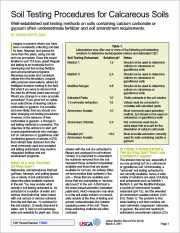What is most commonly overlooked when discussion soil fertility is calcium—more specifically, the form and application of calcium to your turf. It’s true that nitrogen, phosphorus and potassium are used in greater percentages than calcium, but no other nutrient is used more by weight and volume than calcium. In the soil, the relationship of calcium to other nutrients (e.g., magnesium, potassium and sodium) is dynamic, so to limit its importance to pH adjustment is short-sighted. Calcium is the second highest element percentage in plant tissue. Literally, then, calcium levels in both soil and plant are the backbone of an effective turf program. read more →
Optimizing Your Overseed Requires the Use of Calcium

I wish I had a dollar for every time I’ve heard, “I had to go back and throw more seed because it didn’t take the first time.” The first question I always ask is “What do you think caused it?” Water, light, heat, traffic, fertility, seed, and a lot of other variables come into play when overseeding fails to germinate and establish uniformly. And guess what, applying calcium before or at time of seeding, helps 90% of the time. Now I say. “Have you applied your Calcium before your overseeding this fall?” “Do you want to increase the germination, uniformity, maturity, and overall plant survival by about 90%?” read more →
Water Made Easy

Many times I see a facility invest a lot of money in equipment or product that they may not necessarily need. Florida’s overall weather patterns are quite easy to predict! (I may be the first to actually believe this.) By this I mean that Florida has a very predictable dry season and an equally predictable wet season. The dry season calls for every turf manager to be ready to amend soils properly to offset potential salt problems in the soil. The wet season usually does not provide enough flushing rainfall to adequately exchange the sodium built up on the soil colloid if those soils haven’t been amended properly during the dry season. read more →
Soil Testing Procedures for Calcareous Soils

Imagine a scenario where you have been consistently collecting soil data for tees, fairways, and greens for more than five years, using one lab and one procedure. Does this sound familiar to you? If it does, great! Regular soil testing is an invaluable tool for developing and fine-tuning fertilizer and soil amendment programs. Receiving accurate and consistent values from the laboratory, coupled with personal observations, allows for intelligent decision making in the field. But what if you were to discover that the data for all those years was wrong? Would you change to a more accurate procedure? read more →
Sodium and Salinity

Sodium (Na+) as an individual element is commonly found in irrigation water, along with many others (like calcium, magnesium, potassium, sulfur and iron, etc). Salts are actually the dry form of two or more elements combined. When salts come in contact with water, they dissolve into their component elements once again, but when in water, they now have a “charge.” The sum charges of dissolved salts constitute the total salinity of the irrigation water, or any other body of water, for that matter. read more →


